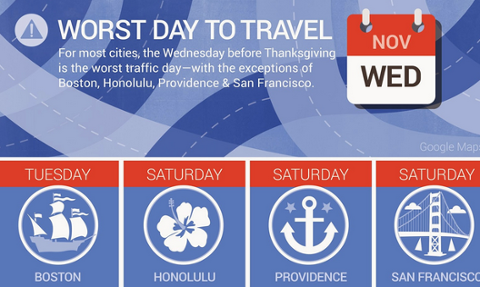 Data-analytics tools have found their way into everything from retail to medicine. Now transportation could be the next industry affected by so-called “Big Data.” Under the terms of a new initiative by the U.S. Department of Transportation, some 33 transportation research centers at colleges and universities will receive roughly $63 million in grants. Those monies will be used to research ways in which technology can improve public-transportation infrastructure. At the University of Texas at Arlington, Stephen Mattingly, an associate professor of civil engineering, will use his federal grant to explore how social media and GPS can support sustainable transportation alternatives. "The aim of the research is to start thinking differently about transportation solutions," Mattingly said, in a statement released by the school. "We just can't continue to build lanes of highways. There have to be more comprehensive, more livable solutions out there." Smartphones and other mobile devices—with an assist from social networks—are capable of collecting data on peoples’ transportation patterns that could, when analyzed by a set of Big Data tools, provide insight into ways local infrastructure can be improved. At least, that’s Mattingly’s hope. The federal government isn’t the only entity interested in exploring how analytics can affect geography and infrastructure. Developers have long relied on Google Maps APIs to give their Websites and apps a bit of geo-locational oomph, and various analysts and pundits have argued for years that the government should open up more cartographical and demographic information to independent developers—taking a page from Google, which used lots of (free) federal data to improve its early versions of Google Maps. But if the feds are willing to pour money into researching how analytics can improve public transportation, and universities are willing to conduct that research, it could result in far more efficient models for moving people across the landscape—provided, of course, there’s sufficient good data for insight. Image: Kryvenok Anastasiia/Shutterstock.com
Data-analytics tools have found their way into everything from retail to medicine. Now transportation could be the next industry affected by so-called “Big Data.” Under the terms of a new initiative by the U.S. Department of Transportation, some 33 transportation research centers at colleges and universities will receive roughly $63 million in grants. Those monies will be used to research ways in which technology can improve public-transportation infrastructure. At the University of Texas at Arlington, Stephen Mattingly, an associate professor of civil engineering, will use his federal grant to explore how social media and GPS can support sustainable transportation alternatives. "The aim of the research is to start thinking differently about transportation solutions," Mattingly said, in a statement released by the school. "We just can't continue to build lanes of highways. There have to be more comprehensive, more livable solutions out there." Smartphones and other mobile devices—with an assist from social networks—are capable of collecting data on peoples’ transportation patterns that could, when analyzed by a set of Big Data tools, provide insight into ways local infrastructure can be improved. At least, that’s Mattingly’s hope. The federal government isn’t the only entity interested in exploring how analytics can affect geography and infrastructure. Developers have long relied on Google Maps APIs to give their Websites and apps a bit of geo-locational oomph, and various analysts and pundits have argued for years that the government should open up more cartographical and demographic information to independent developers—taking a page from Google, which used lots of (free) federal data to improve its early versions of Google Maps. But if the feds are willing to pour money into researching how analytics can improve public transportation, and universities are willing to conduct that research, it could result in far more efficient models for moving people across the landscape—provided, of course, there’s sufficient good data for insight. Image: Kryvenok Anastasiia/Shutterstock.com Big Data and Your Bike Lane
 Data-analytics tools have found their way into everything from retail to medicine. Now transportation could be the next industry affected by so-called “Big Data.” Under the terms of a new initiative by the U.S. Department of Transportation, some 33 transportation research centers at colleges and universities will receive roughly $63 million in grants. Those monies will be used to research ways in which technology can improve public-transportation infrastructure. At the University of Texas at Arlington, Stephen Mattingly, an associate professor of civil engineering, will use his federal grant to explore how social media and GPS can support sustainable transportation alternatives. "The aim of the research is to start thinking differently about transportation solutions," Mattingly said, in a statement released by the school. "We just can't continue to build lanes of highways. There have to be more comprehensive, more livable solutions out there." Smartphones and other mobile devices—with an assist from social networks—are capable of collecting data on peoples’ transportation patterns that could, when analyzed by a set of Big Data tools, provide insight into ways local infrastructure can be improved. At least, that’s Mattingly’s hope. The federal government isn’t the only entity interested in exploring how analytics can affect geography and infrastructure. Developers have long relied on Google Maps APIs to give their Websites and apps a bit of geo-locational oomph, and various analysts and pundits have argued for years that the government should open up more cartographical and demographic information to independent developers—taking a page from Google, which used lots of (free) federal data to improve its early versions of Google Maps. But if the feds are willing to pour money into researching how analytics can improve public transportation, and universities are willing to conduct that research, it could result in far more efficient models for moving people across the landscape—provided, of course, there’s sufficient good data for insight. Image: Kryvenok Anastasiia/Shutterstock.com
Data-analytics tools have found their way into everything from retail to medicine. Now transportation could be the next industry affected by so-called “Big Data.” Under the terms of a new initiative by the U.S. Department of Transportation, some 33 transportation research centers at colleges and universities will receive roughly $63 million in grants. Those monies will be used to research ways in which technology can improve public-transportation infrastructure. At the University of Texas at Arlington, Stephen Mattingly, an associate professor of civil engineering, will use his federal grant to explore how social media and GPS can support sustainable transportation alternatives. "The aim of the research is to start thinking differently about transportation solutions," Mattingly said, in a statement released by the school. "We just can't continue to build lanes of highways. There have to be more comprehensive, more livable solutions out there." Smartphones and other mobile devices—with an assist from social networks—are capable of collecting data on peoples’ transportation patterns that could, when analyzed by a set of Big Data tools, provide insight into ways local infrastructure can be improved. At least, that’s Mattingly’s hope. The federal government isn’t the only entity interested in exploring how analytics can affect geography and infrastructure. Developers have long relied on Google Maps APIs to give their Websites and apps a bit of geo-locational oomph, and various analysts and pundits have argued for years that the government should open up more cartographical and demographic information to independent developers—taking a page from Google, which used lots of (free) federal data to improve its early versions of Google Maps. But if the feds are willing to pour money into researching how analytics can improve public transportation, and universities are willing to conduct that research, it could result in far more efficient models for moving people across the landscape—provided, of course, there’s sufficient good data for insight. Image: Kryvenok Anastasiia/Shutterstock.com 